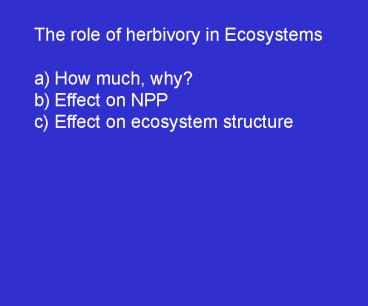The role of herbivory in Ecosystems - PowerPoint PPT Presentation
1 / 21
Title:
The role of herbivory in Ecosystems
Description:
all plants (save, perhaps some GMO agronomic. mutants) have chemical defenses... Increased labile nutrient inputs (e.g., urea quickly. mineralized to ammonium) ... – PowerPoint PPT presentation
Number of Views:33
Avg rating:3.0/5.0
Title: The role of herbivory in Ecosystems
1
- The role of herbivory in Ecosystems
- How much, why?
- Effect on NPP
- Effect on ecosystem structure
2
From Monday all plants (save, perhaps some GMO
agronomic mutants) have chemical defenses
a) Lignins, tannins, etc. to dilute quality,
reduce assimilation (long-lived,
expensive) b) small molecular poisons (short
lived, cheaper per unit, but
non-stable) These defenses work on generalist
herbivores, but specialized herbivores have
co-evolved and find mechanisms to deal with the
chemicals.
3
What happens if you allocate to defense and
nobody shows up? Use mobile defenses only when
attacked. Inducible defenses (herbivory
stimulates allocation to production of defensive
chemicals)
4
Inducible defenses now appear to be documented
for at least some plant species. These involve
the production of small molecular
poisons. Further, some plants apparently do
possess the ability to detect the threat of
herbivory Some plants also release chemicals
that attract predators of herbivores! (dial
911!) Whew!
5
Other tricks plants use to discourage herbivores?
Morphology Hired guards ??? Once again, we see
a theme of trading energy (as thorns, or as
sugars to feed ants, etc.) in exchange for a
fitness benefit Over evolutionary time,
herbivory has decreased NPP because allocation
goes to defense rather than to growth.
6
What evidence do we have that predators control
herbivores in natural ecosystems? Its hard
to manipulate plant chemistry but its
relatively easy to manipulate predator densities!
7
Predation exerts a powerful effect on trophic
interactions and ecosystem structure (especially
in aquatic ecosystems)
8
Predation and other factors also influence energy
flow
9
The arctic tundra can be a 1, 2 and 3 trophic
level system (think cycle)
10
In the arctic tundra, lemmings can create A
temporal trophic cascade.
Almost few/some
high almost no No predators
predators predators predators
Low lemmings increasing high
low lemmings
npp
Time (years)
11
In most ecosystems, herbivore abundance is
controlled by BOTH the combination of plant
physical and chemical defenses (which at a
minimum slow growth) AND predation (top-down
controls). Given this.what is the effect of
herbivory on annual patterns of NPP. The
evolutionary effects are negativebut what about
ecological effects?
12
Under selected conditions Herbivore consumption
increases NPP!
13
moderately grazed
ungrazed
Annual Foliage Production NPP
Heavily grazed
14
Optimal amount of biomass to maximize NPP
Lack of biomass limits NPP
Foliage productivity Per area per unit time (NPP)
0
Biomass or leaf area (amount)
Too much biomass for net gain in NPP
15
Key point Net primary productivity (NPP)
the relative growth rate (RGR) of a unit of
foliage (g/g/unit time) Times the amount of
foliage (g/m2) g/g/unit time g/m2 g/
m2/unit time
16
Ecosystem benefits of grazing Increased labile
nutrient inputs (e.g., urea quickly mineralized
to ammonium) Relatively High quality CN litter
(cow poo!) Removal of light limitation
(tallgrass only) Reduced leaf area may improve
water conservation for plant
17
Sam McNaughton, 1979
over-compensation
Sams data
compensation
NPP
Significance of Coevolution? Artificial
grazing lawns?
My garden, agriculture (undercompensation)
18
biomass
19
Rangeland lost (FAO)
20
Causes - OvergrazingA dead cow lies on parched
earth near Koren Adua in southern Niger.
Overgrazing has exacerbated desertification in
the Sahel, a 5500 km band of semi-arid grassland
stretching across south West Africa.
21
desertification































